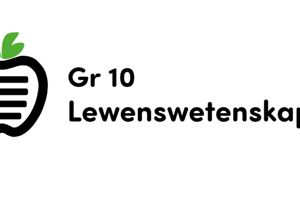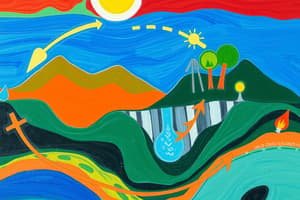Podcast
Questions and Answers
What is the primary effect of reduced evapotranspiration in rainforests?
What is the primary effect of reduced evapotranspiration in rainforests?
- Increased humidity in the air
- Higher rates of precipitation
- Increased risk of drought (correct)
- Enhanced soil fertility
How does the rainforest canopy influence rainfall?
How does the rainforest canopy influence rainfall?
- It accelerates evaporation
- It absorbs all rainfall
- It reflects rainfall back into the atmosphere
- It intercepts 37.5% of rainfall (correct)
Which process is significantly enhanced in tropical climates due to warm and wet conditions?
Which process is significantly enhanced in tropical climates due to warm and wet conditions?
- Decomposition (correct)
- Condensation
- Sedimentation
- Evaporation
What is a key consequence of deforestation in Indonesia as highlighted in the content?
What is a key consequence of deforestation in Indonesia as highlighted in the content?
What function do drip tip leaves serve in rainforest ecosystems?
What function do drip tip leaves serve in rainforest ecosystems?
What occurs when solar energy causes liquid water to transform into water vapor?
What occurs when solar energy causes liquid water to transform into water vapor?
What is the primary function of a drainage basin?
What is the primary function of a drainage basin?
How does land use affect hydrology in vegetated areas?
How does land use affect hydrology in vegetated areas?
Which process describes the downward movement of water through soil and rock due to gravity?
Which process describes the downward movement of water through soil and rock due to gravity?
What happens when rainfall intensity exceeds the infiltration rate?
What happens when rainfall intensity exceeds the infiltration rate?
What is the process by which gas becomes liquid as air cools?
What is the process by which gas becomes liquid as air cools?
What is the combined sum of evaporation and plant transpiration from the Earth's surface to the atmosphere called?
What is the combined sum of evaporation and plant transpiration from the Earth's surface to the atmosphere called?
How do coarse soils impact the infiltration rate compared to saturated or frozen soils?
How do coarse soils impact the infiltration rate compared to saturated or frozen soils?
What is the effect of reduced vegetation roots on infiltration rates?
What is the effect of reduced vegetation roots on infiltration rates?
Which factor is most likely to cause flashy hydrographs?
Which factor is most likely to cause flashy hydrographs?
How does arable farming influence surface runoff?
How does arable farming influence surface runoff?
Which of the following is a consequence of deforestation?
Which of the following is a consequence of deforestation?
What role does afforestation play in watershed dynamics?
What role does afforestation play in watershed dynamics?
What is the result of having impermeable surfaces in urban areas?
What is the result of having impermeable surfaces in urban areas?
What effect does heavy rainfall have on soil infiltration rates?
What effect does heavy rainfall have on soil infiltration rates?
Which practice promotes greater infiltration in agricultural land?
Which practice promotes greater infiltration in agricultural land?
What is a consequence of prolonged rainfall on watersheds?
What is a consequence of prolonged rainfall on watersheds?
What effect does planting trees have in a watershed?
What effect does planting trees have in a watershed?
What is the primary consequence of rapid overland flow?
What is the primary consequence of rapid overland flow?
How can drought affect water stores in the environment?
How can drought affect water stores in the environment?
What happens to aquifers when the water table drops below sea level?
What happens to aquifers when the water table drops below sea level?
What is the function of evapotranspiration in a watershed?
What is the function of evapotranspiration in a watershed?
What role does evapotranspiration play during periods of drought?
What role does evapotranspiration play during periods of drought?
How does land use for irrigation in the Middle East directly impact aquifers?
How does land use for irrigation in the Middle East directly impact aquifers?
What is the effect of frozen soils on water movement?
What is the effect of frozen soils on water movement?
During extreme weather events, what happens to soil moisture content?
During extreme weather events, what happens to soil moisture content?
What is the main driver of high rates of evapotranspiration in dry conditions?
What is the main driver of high rates of evapotranspiration in dry conditions?
Which process is likely to be affected negatively by reduced water in the drainage basin?
Which process is likely to be affected negatively by reduced water in the drainage basin?
What is the condition for infiltration excess overland flow to occur?
What is the condition for infiltration excess overland flow to occur?
In which season is saturation excess overland flow more common in the UK?
In which season is saturation excess overland flow more common in the UK?
What primarily drives baseflow in a river's discharge?
What primarily drives baseflow in a river's discharge?
How does the shape of a drainage basin affect a river's hydrograph?
How does the shape of a drainage basin affect a river's hydrograph?
What soil type is most likely to increase saturation excess overland flow?
What soil type is most likely to increase saturation excess overland flow?
Which of the following factors can decrease through flow and infiltration in a watershed?
Which of the following factors can decrease through flow and infiltration in a watershed?
What effect does land use change typically have on hydrology?
What effect does land use change typically have on hydrology?
What role does transpiration play in the hydrological cycle?
What role does transpiration play in the hydrological cycle?
How does impermeable land surface affect overland flow?
How does impermeable land surface affect overland flow?
Which factor is least likely to influence hydrograph characteristics?
Which factor is least likely to influence hydrograph characteristics?
Flashcards
Infiltration Rate
Infiltration Rate
The speed at which soil absorbs water.
Infiltration Capacity
Infiltration Capacity
The maximum rate at which soil can absorb water.
Evapotranspiration
Evapotranspiration
The sum of evaporation and plant transpiration from the Earth's surface to the atmosphere.
Condensation
Condensation
Signup and view all the flashcards
Evaporation
Evaporation
Signup and view all the flashcards
Drainage Basin
Drainage Basin
Signup and view all the flashcards
Coarse Soils
Coarse Soils
Signup and view all the flashcards
Watershed
Watershed
Signup and view all the flashcards
Low infiltration rates
Low infiltration rates
Signup and view all the flashcards
Field Capacity
Field Capacity
Signup and view all the flashcards
Saturation Excess Overland Flow
Saturation Excess Overland Flow
Signup and view all the flashcards
Lag time
Lag time
Signup and view all the flashcards
Aquifer depletion
Aquifer depletion
Signup and view all the flashcards
Saltwater contamination
Saltwater contamination
Signup and view all the flashcards
Water Abstraction
Water Abstraction
Signup and view all the flashcards
Reduced Throughflow
Reduced Throughflow
Signup and view all the flashcards
Drought
Drought
Signup and view all the flashcards
Flash Hydrographs
Flash Hydrographs
Signup and view all the flashcards
H Factor - Deforestation
H Factor - Deforestation
Signup and view all the flashcards
H Factor - Urbanization
H Factor - Urbanization
Signup and view all the flashcards
H Factor - Agriculture
H Factor - Agriculture
Signup and view all the flashcards
H Factor - Afforestation
H Factor - Afforestation
Signup and view all the flashcards
Sedimentation
Sedimentation
Signup and view all the flashcards
Overland Flow
Overland Flow
Signup and view all the flashcards
Interception
Interception
Signup and view all the flashcards
Infiltration
Infiltration
Signup and view all the flashcards
Rainforest Carbon Cycle
Rainforest Carbon Cycle
Signup and view all the flashcards
Decomposition in Rainforests
Decomposition in Rainforests
Signup and view all the flashcards
Combustion in Rainforests
Combustion in Rainforests
Signup and view all the flashcards
Vegetation Role in Rainforest Carbon Cycle
Vegetation Role in Rainforest Carbon Cycle
Signup and view all the flashcards
Drip Tip Leaves in Rainforests
Drip Tip Leaves in Rainforests
Signup and view all the flashcards
Infiltration Excess Overland Flow
Infiltration Excess Overland Flow
Signup and view all the flashcards
Baseflow
Baseflow
Signup and view all the flashcards
Shape of drainage basin
Shape of drainage basin
Signup and view all the flashcards
Impermeable Soil/Rock
Impermeable Soil/Rock
Signup and view all the flashcards
Peak Discharge
Peak Discharge
Signup and view all the flashcards
Throughflow
Throughflow
Signup and view all the flashcards
Study Notes
Water and Carbon Cycle
-
Positive Feedback: Effects of an action are amplified by a secondary effect.
-
Negative Feedback: Effects of an action are nullified by knock-on effects, returning the system to balance.
-
5 Major Subsystems: Hydrosphere, atmosphere, biosphere, lithosphere, and cryosphere.
-
Open System: Matter and energy can be transferred from the system to the environment (e.g., drainage basin).
-
Closed System: Energy transfers occur but not matter.
-
Dynamic Equilibrium: Tendency towards a natural state of balance within a changing system.
-
Hydrosphere: Water on or near Earth's surface (97% oceanic). Inputs include precipitation and runoff; outputs include evaporation.
-
Cryosphere: Portions of Earth's surface where water is solid (1.7% of water). Includes ice sheets, ice caps, glaciers, and permafrost.
-
Lithosphere: Solid outer layer of the Earth's crust and upper mantle (1.7% of water), storing water for longest durations.
-
Atmosphere: 0.01% of Earth's water, primarily water vapor.
Other Key Concepts
-
Biosphere: Part of Earth where life exists (land, water, and air).
-
Cryospheric Change: Growth and reduction in size of the cryosphere due to warming or cooling periods. Feedback loops influence ice melt and water levels.
-
P-factors (Steepness/Vegetation): Natural land uses increase interception, root uptake, and evapotranspiration = decreased surface runoff and flooding. Steep sides correlate with faster overland flow and flashy hydrographs.
-
H-factors (Deforestation/Urbanisation): Deforestation reduces interception and evapotranspiration rates, leading to increased surface runoff and flashy hydrographs. Urbanization results in less infiltration and increased, fast-flowing overland flow.
-
Infiltration: Downward movement of water into the soil.
-
Infiltration Rate: Speed at which soil absorbs water.
-
Infiltration Capacity: Maximum rate at which soil can absorb water.
-
Evapotranspiration: Combined process of evaporation and plant transpiration.
-
Condensation: Change from gas (water vapor) to liquid (water).
-
Evaporation: Conversion of liquid water to water vapor due to solar energy.
-
Drainage Basin: Area that supplies a river with water (separated by a water shed).
-
Percolation: Downward movement of water due to gravity.
-
Throughflow: Water flowing horizontally through the top soil layer.
-
Throughfall: Rainfall that falls directly onto the ground without interception.
-
Interception: Process where water is prevented from reaching the ground surface by vegetation.
-
Natural Features of River Exe: The area is 82% woodland and grassland, which increases interception, root uptake, and evapotranspiration.
-
Exmoor Mires Project: Aim to restore peatlands to improve water storage and reduce flood risk. Improved water quality and biodiversity. Increased water table.
-
Wimbleball Reservoir: Construction (1979) regulated water levels, reduced flood/drought risks.
-
Intertropical Convergence Zone (ITCZ): Area where warm, moist air rises close to the equator and results in high pressure.
-
Global Atmospheric Circulation (GAC): Large-scale air movement redistributing thermal energy across the earth. Winds are created by atmospheric pressure differences.
-
Corolis Effect: Bending of air currents due to Earth's rotation. Relates to climate patterns (pressure, wind).
-
Soil Water Balance: Relationship between inputs (precipitation) and outputs (evapotranspiration and discharge), which can be positive, negative, or balanced.
-
Decomposition: Breakdown of organic matter by organisms. This releases CO2 back into the atmosphere.
-
Combustion: Burning of organic matter, releasing CO2.
-
Dissolution: Carbon dissolves in the oceans. Cold water absorbs more CO2 compared to warm water.
-
Sequestration: Capture and storage of carbon in rocks or other natural systems.
-
Weathering: Breakdown of rocks by chemical or physical processes.
-
Burial and Compaction: Over time, organic matter is buried under sediment, eventually forming hydrocarbons such as coal and oil (lithosphere).
-
Carbon Stores: Locations where carbon is stored (lithosphere, hydrosphere, atmosphere, biomass).
-
Fluxes: Rate at which carbon flows between stores.
-
Differences between Weathering and Erosion: Weathering is the breakdown of rocks, while erosion involves the transportation of sediment.
-
Gaia Hypothesis: Living matter (plants, animals) regulates life-sustaining conditions on earth.
-
Global Distribution of Carbon: High levels especially in forests in South America.
-
Net Primary Productivity: Measurement of ecological activity in an area.
-
Lithosphere (carbon): Locations containing inorganic (fossil fuels) or organic (litter, humus) forms of carbon.
-
Hydrosphere (carbon): Carbon is stored in water bodies (ocean) through various processes.
-
Biosphere (carbon): Carbon is stored in living organisms from plants to plankton
-
Climate Climax: Natural stage where environment is stable and fully developed (e.g., forest).
-
Halosere: Succession in saline environments.
-
Psammosere: Succession on sand dunes / environments in sandy areas
-
Hydrosere: Succession in water environments.
-
Pioneer species: First organisms to colonize a barren area.
-
Dominant species: Most abundant species in a community.
-
Plagioclimax: Human impact has prevented a climax community from developing (e.g., deforestation).
-
Polyclimax: Many factors effect community development, rather than just climate variables.
-
Deforestation (positive and negative): Reduces global warming due to albedo in certain examples, while negative effects are primarily linked to ecosystem destruction, soil erosion, and increased risk of flooding.
-
Arctic Circle: Warming trends impact permafrost thaw which leads to co2 and methane emissions.
-
Hockey Stick Graph: Climate change illustrated using graph showing warming trend in recent times.
-
Land Use Change (carbon): Impacts on carbon cycles by converting sinks to sources.
-
Livestock Sector: Significant methane emissions from livestock (enteric fermentation and rice paddies).
-
Methane Sources: Cattle enteric fermentation (digestion), rice paddies, and other sources (manure, fossil fuels).
-
Nitrous Oxide Sources: Fertilizers, manure, industrial processes.
-
Impact of Increased Agriculture: Negative impacts (soil erosion, ecosystem loss) and positive (Increased food production)
-
Impact of Arctic Warming: Thawing permafrost leads to release of stored CO2 and methane, creating a positive feedback loop accelerating warming.
-
How Does Desertification Occur Due To Farming? Overuse of land (cultivation, irrigation, grazing) on marginal land. Water usage, reduced water tables due to irrigation may lead to desertification.
-
Wetlands: Stores considerable carbon and act as important sinks for carbon.
-
Fossil Fuels (Hydrocarbons): Stored carbon, released as CO2 through combustion impacting carbon cycle.
-
Impact of Urbanisation on Carbon Cycle: Concrete and other materials hinder plant growth and photosynthesis, changing natural carbon sinks to sources. This releases additional CO2 into the atmosphere.
Studying That Suits You
Use AI to generate personalized quizzes and flashcards to suit your learning preferences.




